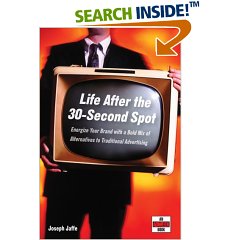von Roland Hachmann | Mai 15, 2007 | Blog, Digital Marketing, Marketing, Online Advertising
This is an excellent execution for an anti-drug campaign from Norway! Showing the effects of drug abuse by visualising the effects on the microsite itself – making it really „tangible“.
On the Marihuana example, everything is blurred and your mousepointer gets annoyingly slow, while it gets incredibly fast and uncontrollable in the cocaine example. And with heroine, everything on the screen looks really shaky and frightening.

The site also opens several pop-unders for bancruptcy sites, memorial sites, etc. all related to possible results of your drug abuse. And when you try to close an example, there is a mockup pretending to notify the police, displaying your IP number, internet provider, etc.
Really well done!
(found on Adverblog.)
von Roland Hachmann | Mai 11, 2007 | Ad News, Blog, Digital Marketing, Marketing, Online Advertising
There is a Businessweek article about Honeyshed, which seems to be a new site for branded content. Apparently, this was launched by agencies in the Publicis Network (Droga5 and Digitas). From what I gathered, it is supposed to provide a platform for clients for offering branded content, be it videos, text, audio, whatever, I don’t know.
Honeyshed intends to erase the line between branding and entertainment altogether. But its content won’t be traditional online advertising. No banners. No rollovers. No 30-second spots. Instead, it will provide a mix of live programming and character-driven sketch shows paid for by—and promoting—sponsors, which will collaborate with Honeyshed to come up with suitably entertaining concepts aimed at the ever-capricious but nonetheless influential demographic of 18- to 35-year-olds.
(I am glad they chose this age bracked – it means I am *just* still part of it!)
„There’s a lot of so-called branded content out there, but it doesn’t have many places to live,“ he says. „It gets lost on YouTube or it’s like bud.tv, a brand in isolation. In contrast, this is totally transparent and completely entertaining. It’s overt advertising based on the idea that people love brands. They just don’t necessarily love it when brands interrupt or deceive them. This will make brands the life of the party rather than the uninvited guest.“
Seems to be an interesting concept. Some launch they’re own channel (Bud TV and Audi TV), and some launch things on YouTube. Which will get more attention? Umair from the Collectivegeneration Blog doesn’t quite agree with the approach of honeyshed…
von Roland Hachmann | Mai 9, 2007 | Ad News, Blog, Marketing, Online Advertising
This is something Frederick Samuel asks here, having presented a viral spot for Ray Ban (which looks, if you ask me, like it has been well post-produced to achieve this effect…)
My reply in the comments was:
good viral means good content and that will continue to be king, nevermind if it is an ad or not. think about it: people don’t forward it, because it is an ad for xyz, quite often, they won’t even be able to tell you the name of the brand or product a few days later.
the challenge with viral is really, to produce good content. to have a remarkable story worth spreading. with an increasing number of viral spots, it will be more difficult to stand out of the clutter enough to be liked&spread. but that is a challenge that classical advertising had all along, so there really isn’t anything new, don’t you think?
What do you think?
von Roland Hachmann | Mai 8, 2007 | Ad News, Blog, Digital Marketing, Marketing, Online Advertising
Some links to stories of the last week or so:
- Print publications in the US are increasingly forced to guarantee hard metrics to advertisers, writes Marketing Vox:
The new demands for better metrics can be attributed to the evolution of web metrics and consequent instant-accountability curve, in addition to the myriad of media options now available to marketers.
- Widgets or Gadgets seem to be on the rise in online Advertising. They’re small customizable ads that can include interactive elements or even streamed rich media. Another reason why „traditional“ metrics in online advertising might have to be rethought.
- NBC Universal, as one of the biggest broadcasters in the US, is moving to „paid per effectiveness“ instead of a regular CPM model… as it says here:
„We were based on a CPM model, and that was fine in the past, but ultimately we would like to be paid [for] advertising effectiveness,“ Comstock said. „It’s about delivering the right message to the right person at the right time, and television doesn’t do that now.“
So if they don’t do that now, have they ever done it?
“A select group of content creators will get promotion on the YouTube platform, and we will help them monetize their content,†said Jamie Byrne, head of product marketing, in an interview on Thursday. “This will help erase the the stigma around the user-created content, and, to be honest, these guys are media entities in their own right.â€
[…] While YouTube had previously said it might populate videos with pre-or-post roll ads as soon as this summer, the monies for the new program will come from the sales of banner ads.
von Roland Hachmann | Mai 1, 2007 | Ad News, Blog, Digital Culture, Digital Marketing, Digital News, Marketing, Mobile Marketing, Online Advertising, SEO / SEA, Social Media Marketing
I am a big fan of Joe. I regularly read his blog and I really enjoy his podcast, listening to it while driving to work (it is really motivational and inspires me a lot, which I enjoy in the morning!).
And I have (finally) read his book. I am very late writing about the book. Why am I writing about it nevertheless?
More than a year ago, Joseph Jaffe came up with a concept he called „UNMTPNM„: Use new marketing to prove new marketing. He launched this idea in order to promote his (then) new book:
Life after the 30-second spot
Energize your brand with a bold mix of alternatives to traditional advertising.

I decided to take part, as I liked the idea of how he wanted to start word-of-mouth this way. Now I want to write the review. It’s late, but I thought better late than never. And this way, Joe gets a new mention during a time, when everyone is already writing about his new book, which should be coming out some time in the middle of this year. Which, by the way, extends on one of the thoughts what new marketing can look like in the future. So here is my review, apologies, again, for it being so late.
His main conclusion throughout this book and his blog and his podcast is always the fact, that traditional advertising is by far no longer as useful as it used to be. Or as he puts it: the 30-second spot has outlived its usefulness.
So what’s in the book? There are 3 main sections:
Section I – The Problem
In this section Joe describes the current state of the media landscape. How mass media are dying due to the fragmentation of media and increasing consumer resistance towards clutter and power of media choice.
This chapter lays out the foundation for the rest of the discussion. By now these things are common knowledge and widely discussed everywhere. Yet, in 2005, when the book was printed, these points were heavily debated everywhere. (And, by the way, in Germany these points are still relevant, considering the fact that we’re usually lagging some time behind.)
Section II – The Solution: Re:think Four Fundamentals of Marketing
In this chapter, Joe is Re:thinking four main areas that need, well, rethinking. These are: the changing consumer, branding, relevance of advertising and the agency/client situation. These chapters are a „theoretical basis“ for the approaches in the third section and . A nice idea: you cannot read chapter 10 within the book. You will have to download the pdf or the mp3 file (to listen to Joe read out that chapter for you).
Section III – 10 Approaches that are transforming the marketing and advertising games
The approaches expanded on in this section are: the internet (of course…), gaming, on-demand viewing, experiential marketing, long-form content, communal marketing, consumer generated content, search, music – mobile and things that make you go mmmm, branded entertainment. In essence this covers examples for all the buzzwords, that companies have been experimenting with in the last couple of years.
Comments on the Contents
The first chapter is rather preaching to the converted and sometimes a bit over the top. The facts might be true, but sometimes you get the feeling as if the world is going to stop, the way Joe writes about the end of „old“ marketing. For anyone reading the book now, the first 60 pages are common knowledge (or should be!). But as a summary on the situation it is not bad.
The second section is the one for me, that had the most juice in it. Purely because these are the backbone thoughts on how to think about marketing in the future. And – in contrast to the third section – these thoughts are more likely to be relevant even in a few years time. The third section covers many examples per approach, but even looking at them now, some already seem antiquated (which doesn’t make them less true).
Comments on the Style
His style of writing is rather conversational. One of the many examples:
„… in a survey conducted by the consultancy Emergence, a grand total of 0 percent (that’s zero, none, nada, squat, zip, nil) of those quizzed…“
That makes it awkward to read sometimes, especially considering it is a book, not a blogpost or a podcast. It is almost, as if he dictated the script for someone else to type it. But, speaking of which: keeping Joes way of talking in mind, you can almost read the book and hear his voice saying these things.
So should you buy it? I think it was Joe himself who once said: buying a book these days is like getting „the t-shirt“. An „I have been there“ thing at times when content itself is readily available everywhere… You could follow Joe’s thoughts through his blog, his podcast, by going to crayonville, etc. But this is the one source that best and most complete summarises what Joe thinks, writes and says about new marketing.
So while the book will not completely stay relevant in the next couple of years, I think it is a very valuable basis for re:thinking marketing and advertising. For anyone who read about the changing media landscape, wanting to find out how to possibly react (and not having had their agency recommend things already, which they should have done), read the book. Skim-read the first section, this should be no news to anyone by now, focus on the second section for strategic visions and get some ideas of what new marketing can look liek from the last section.
Don’t forget: you can order it online. (Any commision amazon might yield will go to Joe, as I copied this link of his website.)



 Wo ich sonst so bin...
Wo ich sonst so bin...